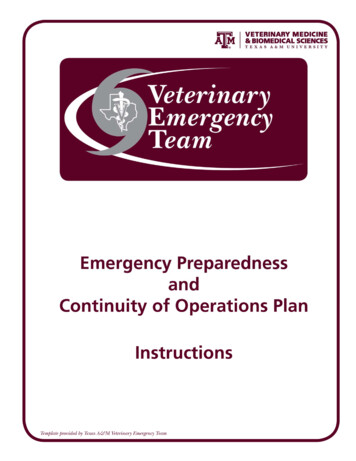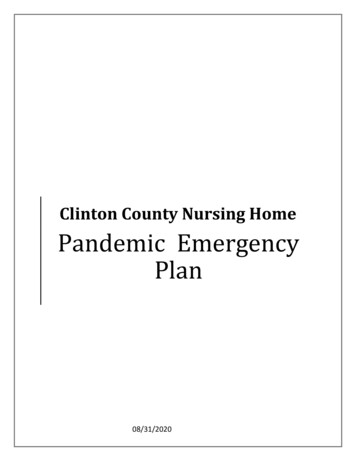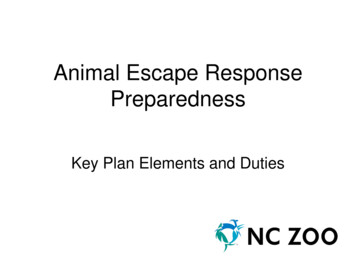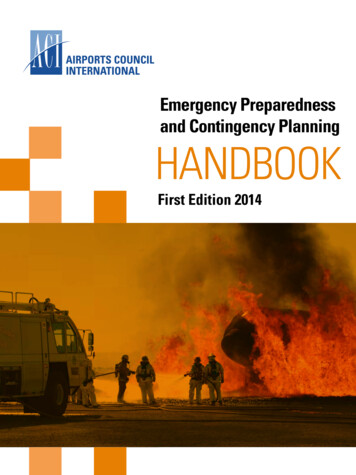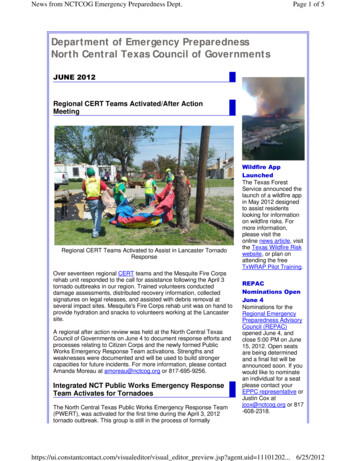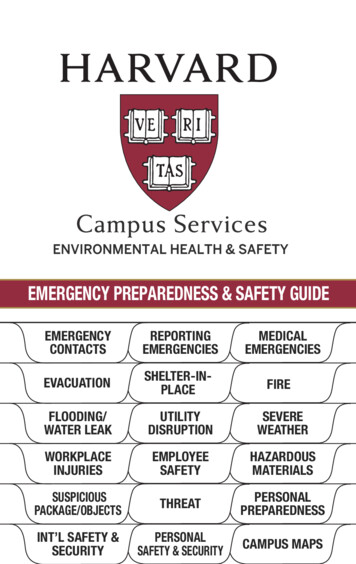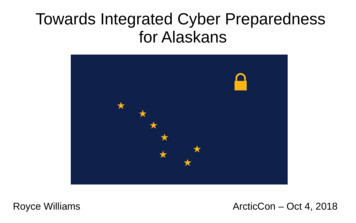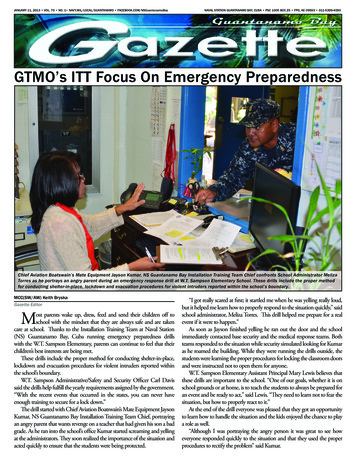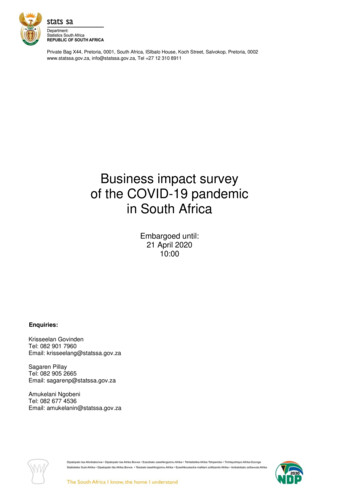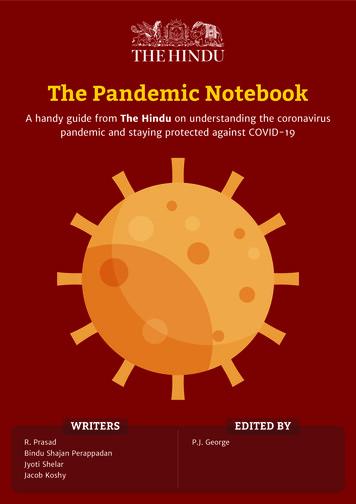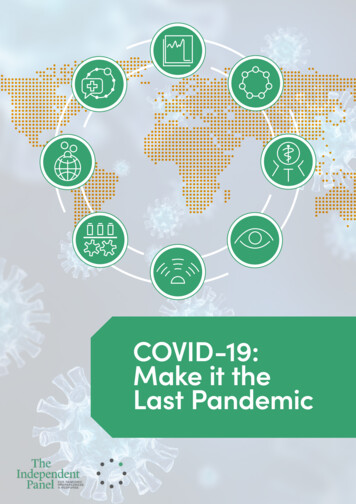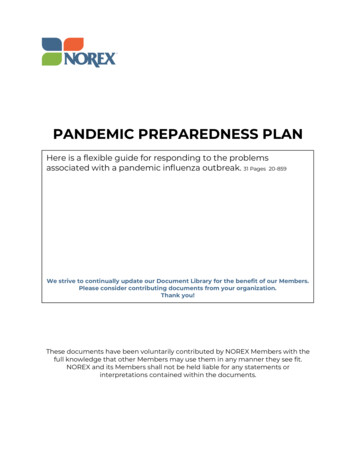
Transcription
PANDEMIC PREPAREDNESS PLANHere is a flexible guide for responding to the problemsassociated with a pandemic influenza outbreak. 31 Pages 20-859We strive to continually update our Document Library for the benefit of our Members.Please consider contributing documents from your organization.Thank you!These documents have been voluntarily contributed by NOREX Members with thefull knowledge that other Members may use them in any manner they see fit.NOREX and its Members shall not be held liable for any statements orinterpretations contained within the documents.
Pandemic Preparedness Plan1. SCOPEThis document defines pandemic preparedness plan template for staff at [ORG].2. PURPOSETo provide a fluid and flexible guide for dealing with the problems associated with a pandemicinfluenza outbreak. This is not written to provide a specific step by step process.3. PROCEDURE/REQUIREMENTS3.1Influenza is a highly infectious viral illness that causes yearly seasonal epidemics, causing anaverage of up to 56,000 deaths in the US each year, primarily among the elderly. Influenza virus istransmitted in most cases by droplets through coughing and sneezing of infected persons, but canbe transmitted by direct contact. Typical symptoms include: 3.1.13.1.23.1.33.1.4Abrupt onset of fever (101 F to 102 F)HeadacheChillsFatigueMuscular pain or tendernessSore throat and nonproductive coughRunny or stuffy noseAnnual influenza vaccination is the best method of protection against influenza. Frequent handwashing, staying home when sick, and institution of public health measures for universalrespiratory hygiene and cough etiquette, will help stop the spread of influenza.Influenza viruses are unique in their ability to cause sudden infection in all age groups on aglobal scale. A pandemic – or global epidemic – occurs when there is a major change in theinfluenza virus so that most or all of the world’s population never exposed previously, is thusvulnerable to the virus. Three pandemics occurred during the 20th Century causing severalmillion deaths worldwide.The impact of the next pandemic could have a devastating effect on the health and wellbeingof the U.S. public. The Centers for Disease Control and Prevention estimates in the UnitedStates between 64 and 94 million people will be infected. In [location] it is estimated thatbetween 5,000 and 72,000 will be hospitalized. Between 1,000 and 21,000 will be in the ICU.There estimated to be between 300 and 12,000 deaths. This is over an 8-week outbreak period.Using a serving population of 300,000 people locally, [ORG] can estimate to have between60,000 and 90,000 infected locally. Admissions will be between 750 and 10,000. ICU admissionswill range from 150 to 3,000. Deaths will range from 45 to 1,700.Effective preventive and therapeutic measures, including vaccines and antiviral agents willlikely be in short supply, as might some antibiotics to treat secondary infections. Health careworkers and other first responders will likely be at even higher risk of exposure and illness thanthe general population, further impeding care of patients. Widespread illness in the community
Pandemic Preparedness Planwill also increase the likelihood of sudden and potentially significant shortages of personnelwho provide other essential community services.3.1.5An influenza epidemic will impact multiple communities across [location] simultaneously.Therefore, contingency planning is required to moderate the impact through a coordinatedeffort between internal health care, and external state and local government, public health,and local partners. Advanced planning for a large scale and widespread public healthemergency is required to optimize health care delivery through a pandemic.3.1.6A Pandemic Influenza Plan was designed to ensure [ORG] is prepared to implement aneffective pandemic response. The plan consists of components consistent with international,federal and state guidelines, as well as general principles of emergency response. It utilizes theNational Incident Command Management System (NIMS) and Hospital Incident CommandSystem (HICS).3.1.7The [ORG] Pandemic Influenza Plan will adjust interventions based on trigger points fromguidelines provided by:3.1.7.1The CDC Pandemic Influenza Plan.3.1.8LEVEL I: Investigation and Recognition3.1.9LEVEL II: Initiation of a pandemic wave3.1.10LEVEL III: Acceleration of a pandemic wave3.1.11LEVEL IV: Deceleration of a pandemic wave3.1.12LEVEL V: Preparation for future pandemic waves3.1.13The [ORG] Pandemic Influenza Plan was developed with the following components: 3.1.14Surveillance PlanCommunications PlanFacility Access, Triage and Admission PlanSurge Capacity PlanOccupational Health PlanClinical GuidelinesEducation and Training PlanMedicines PlanPsychosocial PlanMortuary PlanThis plan outlines roles, responsibilities, and key activities before, during and following apandemic influenza. It will be modified as situations dictate.
Pandemic Preparedness Plan3.2 Surveillance Plan3.2.1LEVEL I: Investigation and Recognition3.2.1.1Periodically review and revise Infection Control Surveillance Plan as appropriate.3.2.1.2Test for influenza per normal lab protocol.3.2.1.3Maintain contact with [location] Health Department for direction of increasedsurveillance, testing parameters, screening parameters, and reports of local cases.Monitoring of seasonal influenza is conducted by Infection Prevention and may include:3.2.1.43.2.1.4.1Number of individuals treated for influenza3.2.1.4.2Number of employees treated for influenza3.2.1.4.3Number of all hospitalized admissions for influenza, or tested for influenza3.2.1.4.4Number of mortality cases from influenza and/or complications of influenza3.2.2Review and educate on Health Alert Network Notification System (HAN). This is acommunications tool that will allow for real time dissemination of information during apandemic flu or other public health event.3.2.3LEVEL II: Initiation of a Pandemic Wave3.2.3.1Infection Prevention to assemble and brief the Infection Control Prevention Team, theEmergency Management Team, and applicable persons within 48 hours of notification ofpandemic flu outside the United States.3.2.3.2Implement hospital surveillance for pandemic influenza in incoming and alreadyadmitted patients.3.2.3.3Any suspected cases are reported to the [location] Health Department at [#]. Ifunreachable the [name] Health Department is contacted at [#].3.2.3.4Areas within the organization are contacted to insure they are aware of heightenedsurveillance level, and screening criteria being used. HAN alerts are shared3.2.4LEVEL III: Acceleration of a Pandemic Wave3.2.4.1Continue with steps outlined above.3.2.4.2Infection Prevention convenes and briefs Infection Prevention Team of pandemic flu inthe United States.3.2.4.3Infection Prevention contacts administration, safety, or other applicable persons.3.2.4.4Notify employees to report their flu-like symptoms immediately to Employee Health orother designated notification system.3.2.4.5Infection Prevention Team and Emergency Management Team meet as determined bypandemic activity.
Pandemic Preparedness Plan3.2.5LEVEL IV: Deceleration of a Pandemic Wave3.2.5.1Activate plan.3.2.5.2Contact the Administrative Supervisor.3.2.5.3Establish incident command; open the Emergency Operations Center/ IncidentCommand Center.3.2.5.4Activate the Medical Alert Plan of [ORG].3.2.5.5Contact the [location] Department of Health and [location] emergency managementagency.3.2.5.6Prior to reporting to their work area, all staff members will be screened by taking theirtemperature and will be questioned about having any flu-like symptoms withinformation recorded.3.2.5.7Measure vaccine availability.3.2.5.8Monitor staffing and other resources that are needed.3.2.5.9Check reports on Health Alert Network and the news for hospitals with pandemicinfluenza cases to determine potential local impact.3.2.6LEVEL V: Preparation for Future Pandemic Waves3.2.6.1Continue surveillance activity as with all alert levels in anticipation of second-wave ofinfluenza.3.2.6.2Gather data to report how many individuals were treated for influenza.3.2.6.3Gather data to report how many employees were treated for influenza.3.2.6.4Gather data of all mortality cases from influenza and/or complications of influenza.3.2.6.5Gather data for total hospital admissions for influenza.3.2.6.6Conduct debriefing of how the Surveillance Plan and Pandemic Flu Plan worked.3.2.6.7Assess the effectiveness of vaccine and antiviral distribution.3.3 Communication Plan3.3.1LEVEL I: Investigation and Recognition3.3.1.1Periodically review and revise Communication Procedure as appropriate.3.3.1.2Place [ORG] Pandemic Influenza Plan on Hello page. Notify employees of availability ofthe plan and state’s declaration of current pandemic level.3.3.1.3Assess need for media training for chief executive officer, chief operating officer, medicaldirector, chief nursing officer, public relations, infection prevention, Medical director ofED, Medical Director of Hospitalists, and Chief of Staff, utilizing Addendum A,“Communications Issues”.
Pandemic Preparedness Plan3.3.1.4Collaborate with Health dept for criteria to set up Flu on Call, and investigate use ofezVisit.3.3.1.5Monitor the national and [state] news media, [location] health department, as well asinternational news media. Include notices from Health Alert Network.3.3.2LEVEL II: Initiation of a Pandemic Wave3.3.2.1Notify employees of the state’s declaration of the current pandemic level via home page.3.3.2.2Post Signs and supplies for respiratory hygiene and cough etiquette in public areas andwaiting rooms.3.3.2.3Emphasize the need for employees to develop homecare kits. Kits will includeinstructions on home-based self-care, information on transmission and preventionmethods, and possibly include minimal supplies, such as a thermometer, Tylenol,Gatorade, masks, gloves and hand sanitizer.3.3.2.4Infection Prevention assembles periodic Communications Team meeting. This teamshould include a vice president, infection control nurse, public relations staff, onephysician and one nurse manager. All public messages to staff, board, or public must gothrough this team or designated Public Information Officer.3.3.2.5Address the following agenda at the Infection Control team meeting:Review key messages from [state], federal CDC and colleague agencies.3.3.2.5.13.3.2.5.2Review and evaluate messages delivered in the prior week by [ORG].3.3.2.5.3Review issues and concerns from callers to the Health ezVisit and others in thepublic; include discussion about rumors and potential for quelling them.3.3.2.5.4Seek agreement on key messages for the week. Create a list of volunteers to coverphones as needed.3.3.2.5.5Seek agreement on modes of delivering key messages (public statements, flyers,advertisements, phone, internet, media, radio and other).Put out an update at the end of each meeting that:3.3.2.5.6 3.3.2.63.3.2.6.1Identifies Administrative Supervisor as clinical spokesperson, and Director ofPublic Relations as media spokespersonReleases an internal statement that all public statements must be routedthrough the PIOContinues recruitment of volunteers to staff the hotlinePut out a statement from [ORG] COO or President for the local community within 48hours of a declaration of Level II or III. The statement should give:Expression of empathy with people’s worries and fears
Pandemic Preparedness PlanConfirmation of known facts and action steps from [ORG]Steps taken to address the unknowns and the constant contact with state andfederal ment of commitment to be here for the long-term and do all that is possibleA list of where people can get information and what they can do to be personallyready3.3.2.6.6Role of pandemic flu hotline workers3.3.2.6.7Resources in [County] or in callers’ own county3.3.2.7Report to Incident Command where resources are needed and where they areunavailable.3.3.2.8Monitor call volume and the topic of questions.3.3.2.9Screen people with medical complaints.3.3.2.10Provide web site and Hello information that features information on flu issues and whatpeople can do to prepare.3.3.3LEVEL III: Acceleration of a Pandemic Wave3.3.3.1Follow Level II steps as outlined above3.3.3.2Notify employees of the state’s declaration of the current pandemic level.3.3.3.3Hold communications team meeting more frequently as needed.3.3.3.4Consider setting up a pandemic flu hotline.3.3.3.5Issue a public statement by [ORG] COO or President following same format as above.3.3.3.6Convene Infection control team and Incident command team to go over key messages,strategies and the pandemic flu plan for [ORG] and the entire community.3.3.4LEVEL IV: Evidence of [state] Pandemic Flu, and Increased and Sustained Transmission inthe General Population3.3.4.1Notify employees of the [state]'s declaration of the current pandemic level via the website.3.3.4.2Set up daily Incident Command meetings3.3.4.3Post door signs as per direction of Incident Commander and/or Infection Prevention.3.3.4.4Consider staffing flu hotline 24 hours per day.3.3.4.5Issue public statement by [ORG] COO or President following same format as above.
Pandemic Preparedness Plan3.3.4.63.3.4.6.1Public via radio3.3.4.6.2Print media releases with updates3.3.4.6.3Web sites3.3.4.6.4Overhead pages3.3.4.73.3.5Develop daily briefings with message that includes empathy, current situation andnumbers, what is not known, what we are doing to address unknowns, what peopleshould do. All staff should monitor:Notify physicians and others as needed about the hotline.LEVEL V: Preparation for Future Pandemic Waves3.3.5.1Notify employees of [state]'s declaration of the current pandemic level via website .Notify medical center employees when it is safe to return to work.3.3.5.2Notify general community through the above communication methods of:3.3.5.33.3.5.3.1[state]'s declaration of the current pandemic level3.3.5.3.2[ORG]’s return to pre-pandemic operations Risk of second3.3.5.3.3wave3.3.5.4Consider producing a narrative of the events of the pandemic period.3.4 Facility Access, Triage and Admission Plan3.4.1LEVEL I: Investigation and Recognition3.4.1.1Develop training program for affected personnel (nursing, security, etc.).3.4.1.2Develop and produce signs to direct everyone, including patients and employees, to thetriage location and post the signs in two locations. The Emergency Department is theonly point of entry for patients during actual pandemic influenza.3.4.1.3Develop signs instructing all patients to let the triage nurse know if they have influenzalike symptoms.
Pandemic Preparedness PlanFigure 1 Example Signage3.4.1.4Develop Pandemic Security Plan.3.4.1.5Establish number of available on-hand beds, stretchers, pillows, blankets, linens,intravenous poles, etc.3.4.1.6Provide screening criteria to CDC as needed.3.4.2LEVEL II: Initiation of a Pandemic Wave3.4.2.1Alert network health care workers of [state]'s declaration of the current pandemic levelvia web site.3.4.2.2Assemble the Infection Control team within 48 hours.3.4.2.3Designate director of security or applicable person to identify, notify and train extrasecurity personnel as needed. Implement Security Plan as needed.3.4.2.4Implement hospital surveillance for pandemic influenza on incoming and alreadyadmitted patients. (See Infection Control Surveillance Plan)3.4.2.5Implement a system for early detection and treatment of health care personnel as perSurveillance and Employee Health plans.3.4.2.6Make available a quantity of quarantine and home care information for staff and public.3.4.2.7Post signs for respiratory hygiene and cough etiquette in all facility public areas,restrooms and other key settings.3.4.2.8Review mutual aid agreements with other hospitals, local home health agencies andother health care groups to obtain adequate staffing during pandemic period.3.4.2.9Place extra supplies of tissues and no-touch waste receptacles in waiting areas.3.4.2.10Maintain high suspicion of patients presenting with influenza-like symptoms.3.4.2.11Evaluate daily census and discharge plans.3.4.2.12Review and confirm room availability throughout [ORG].
Pandemic Preparedness Plan3.4.3LEVEL III and IV: Acceleration of Pandemic wave and Deceleration of a pandemic wave3.4.3.1Activate Pandemic Influenza Plan, and the Emergency/Disaster Preparedness Plan.3.4.3.2Establish the incident Command and open the Incident command Center.3.4.3.3Ask Human Resources to provide an accurate list of Medical Center employees andphone numbers.3.4.3.4Contact [location] Health Department and [location] emergency managementoffice.3.4.3.5Based on input from [state] Health Department, ask senior leadership to considercanceling or closing non-critical departments. Criteria for closure include staffing andpatient exposure to infection.3.4.3.6Deliver extra stretchers, supplies to Triage area.3.4.3.6.1Access Control3.4.3.6.1.1Consider lock-down all entrances except the ED entrance East and West, theMain Entrance East and West and the Plaza Entrance East and post security atthe entrance to the emergency department.3.4.3.6.1.2Put up signs directing all patients how to enter the Medical Center.3.4.3.6.1.3Assign security to assist in limiting access as needed.3.4.3.6.1.4Post signs at each entrance with instructions for patients to immediately tellthe triage nurse if they have flu symptoms.3.4.3.6.1.5Employees should use entrance designated for them.3.4.3.6.1.6Have security and triage personnel screen and record employees withinfluenza symptoms and send them home if present, unless they need furthermedical attention. Place daily sticker on name tag if employee is cleared towork.3.4.3.6.1.7Consider closing [locations].3.4.3.6.2Triage Guidelines3.4.3.6.2.1Assign a nurse to triage each entrance.3.4.3.6.2.2Allow one patient at a time to enter and undergo rapid triage by a nurse.3.4.3.6.2.3Segregate patients with an influenza-like illness.3.4.3.6.2.4Evaluate these patients in the triage area, admitting them or sending themhome with self-care and home care instructions.3.4.3.6.2.5Patients without flu-like symptoms will be directed to the appropriate service.3.4.3.6.2.6Other patients will be triaged, evaluated and treated in the ER as usual.
Pandemic Preparedness Plan3.4.3.6.2.7Screen all visitors and volunteers through designated entrance for influenza.Send home any with positive findings unless they need further medicalevaluation.3.4.3.6.2.8Establish a backup plan. If entrances are overwhelmed with influenza patients,The College of Health Sciences and conference centers on East and West couldbe converted to another flu outpatient area where triage and initial treatmentcan be done. Notify [location] Emergency Management Office if we need atrailer for mass clinic or triage.3.4.3.6.2.9In this backup plan, non-influenza patients seeking care will be treated perusual in the ER. All employees and staff are to report to designated entrance.All will be evaluated; temperatures and symptoms will be recorded.3.4.3.6.2.10If the front entrance becomes too busy, consider having employees enterthrough an alternate entrance.3.4.3.6.33.4.4Hospital Admissions3.4.3.6.3.1Defer elective admissions and procedures until local epidemic wanes (schoolsback in session).3.4.3.6.3.2Discharge appropriate in-house patients as soon as possible.3.4.3.6.3.3Locate patients admitted with influenza to a single wing or area. Remove allnon- influenza patients from identified influenza area.3.4.3.6.3.4Isolate all patients admitted with droplet precautions per isolation precautionstandards. (See Addendum C.)3.4.3.6.3.5Limit visitors to only those who are essential for patient support and who havebeen cleared of influenza symptoms.3.4.3.6.3.6Consider temporarily closing the hospital to new admissions after consideringsurge capability, staffing ratios, isol
3.2.4.3 Infection Prevention contacts administration, safety, or other applicable persons. 3.2.4.4 Notify employees to report their flu-like symptoms immediately to Employee Health or other designated notification system. 3.2.4.5. Infection Prevention Team and Emergency
